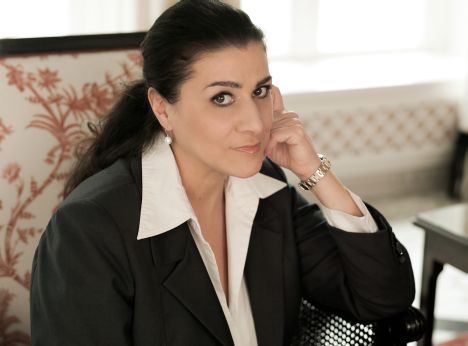
A musical biography of Cecilia Bartoli
Together with the Latvian Elīna Garanča, the Italian Cecilia Bartoli is one of the world’s leading mezzo-sopranos. Cecilia was born in Rome on June 6, 1966. Both her parents, Silvana Bazzoni and Angelo Bartoli, were professional singers. Her mother, was a soprano who abandoned her solo career in favor of her three children and subsequently only sang in the choir of the Roman Opera. Cecilia’s parents divorced and her father, a tenor, continued his (minor) career in Rimini. Incidentally, Cecilia Bartoli lives in Zurich, Switzerland.
The parents, mainly Silvana Bazzoni, taught Cecilia, who also studied at the Conservatorio di Santa Cecilia in Rome. At the age of 9, Cecilia made her first public appearance as a shepherd boy in Giacomo Puccini‘s Tosca. At 19, she participated in the talent show Fantastico and immediately received an invitation by the director Riccardo Muti to audition at the famous Scala in Milan.
Cecilia Bartoli worked with Herbert von Karajan on Bach’s Mass in B Minor and was invited by him to participate in Salzburg’s Osterfestspiele in 1990, which did not materialize because of the conductor’s death. Nevertheless, the Italian coloratura mezzo-soprano was already unstoppable.
Cecilia Bartoli had made her professional opera debut at the Arena di Verona in 1987. She starred as Rosina in Gioachino Rossini‘s Il Barbiere di Siviglia at the Zurich Opera, in Barcelona, Hamburg, Rome, Lyon, Houston and Dallas.
Subsequently, she worked with many other famous conductor’s, including Nikolaus Harnoncourt and Daniel Barenboim, who had spotted her on a French TV tribute to Maria Callas.

Cecilia Bartoli. Sacrificium 2009. Photos © Universal Music.
Wolfgang Amadeus Mozart is one of Bartoli’s favorite composers. She has sung many of his opera parts, including Zerlina in Don Giovanni under Muti/Strehler at La Scala and under Barenboim/Chéreau at the Salzburger Festspiele, Dorabella in Così fan tutte, Cherubino in Le Nozze di Figaro at the Zurich Opera under Harnoncourt/Ponnelle as well as Idamantes in Idomeneo at the Hamburger Staatsoper (1990).
Cecilia Bartoli sang the title role in La Cenerentola at the opera house in Bologna and Despina in a Muti/De Simone production of Così fan tutte at the Theater an der Wien.
At the Scala in 1991, she sang the role of Isolier in Rossini‘s Le comte Ory. In 1996 followed her debut at New York’s Metropolitan Opera as Despina in Mozart‘s Così fan tutte (Levine/Koenig). She returned in 1997 to sing the title role in La Cenerentola(Levine/Lievi). In 2000, she starred as Donna Elvira in Mozart’s Don Giovanni at the Deutsche Oper in Berlin. The following year came her debut at London’s Covent Garden with Haydn’s L’anima del filosofo.
The coloratura mezzo-soprano Cecilia Bartoli also made herself a name by rediscovering lesser known artists and music, searching in archives for suitable material. She did not only record albums with compositions by the famous Gluck, Vivaldi and Haydn, but also one with compositions by Mozart’s rival Antonio Salieri. She recorded a CD in the memory of the legendary singer Maria Malibran. On her 2009-album Sacrificium, she explores the music of the castratos.
I have seen several of Cecilia Bartoli’s concerts. She is a stage animal with a rare ability to connect with the audience. She has a winning personality and a lively temperament. In Berlin, I saw her in stunning form in the second part of her performance with the Berliner Philharmoniker under the direction of Simon Rattle (who was celebrated like a rock star after the concert by a young group of fans). In Naples (Italy) on October 24, 2008 as a surprise guest at a free concert (!) in the Piazza Plebiscito starring Andrea Boccelli, Cecilia Bartoli was rather a side act but still a joy to watch, although overshadowed in the open by Boccelli’s powerful voice.
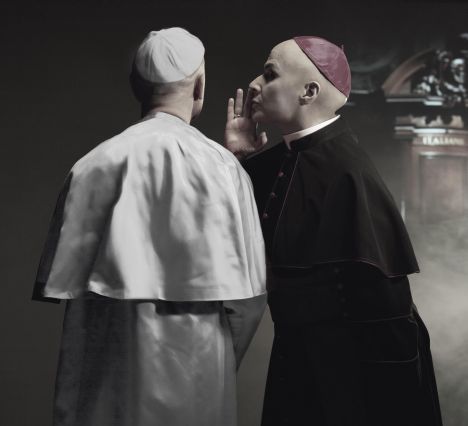
Cecilia Bartoli: Mission, 2012. Photos Coypright © Decca/Uli Weber. Order the CD Mission from Amazon.com, Amazon.co.uk, Amazon.de and Amazon.fr.
Sacrificium (Porpora and the castrato music)
In Rome from 1600, for almost three centuries, soprano and alto parts in church were sung by castratos. The most famous centers of castration were all in present-day Italy: Naples (where 2000 to 3000 boys were castrated every year), Venice, Bologna, Milan and Florence.
The last famous castrato was Alessandro Moreschi (1858-1922). He was active in rome until 1913, even after the formal ban by Pope Pius X for castratos to perform in churches. He sang from 1873 at the Lateran Basilica, in the Papal chapel, in the Sistine Chapel choir, for the state funerals of King Vittorio Emanuele II and King Umberto I. In 1902 and 1904, Moreschi recorded a few pieces, which constitute the only document of the sound of an important castrato voice.
Cecilia Bartoli’s CD Sacrificium centers on the music of the age of castratos. As several other albums, Cecilia Bartoli recorded Sacrificium together with Il Giardino Armonico, an Italian ensemble founded in Milan in 1985 by Luca Pianca and Giovanni Antonini, focusing mainly on 17th- and 18th-century Baroque music played on period instruments.
Sacrificium (deluxe 2-CD limited edition) contains 15 arias, 4 of which are by the composer, teacher and impresario Nicola Porpora (1686-1768), 2 by Antonio Caldara (?1671-1738) and 2 by Carl Heinrich Graun (c. 1703-1759). It includes 11 world-premiere recordings and 3 castrato hits, including Riccarodo Broschi’s (c. 1698-1756; Farinelli’s brother) “Son qual nave” from Artaserse, which premiered in London in 1734, Georg Friedrich Händel‘s “Ombra mai fu” from Serse, which premiered in London in 1738 and Geminiano Giacomelli’s “Sposa, non mi conosci” from Merope, which premiered in Venice in 1734.
Nicola Porpora’s pupils included the most famous castrati, namely Farinelli, Caffarelli, Salimbeni, Appiani and Porporino. In addition, he also taught the opera librettist Pietro Metastasio and the composers Johann Adolf Hasse and Joseph Haydn.
Porpora died in Naples on March 3, 1768 forgotten and in poverty. Cecilia Bartoli revives his and the art of other composers of his era on Sacrificium. Order the double CDSacrificium with booklet (150 pages in English, French and German) from Amazon.com, Amazon.co.uk, Amazon.fr, Amazon.de.

Cecilia Bartoli: Mission, 2012. Photos Coypright © Decca / Uli Weber. Order the CD Mission from Amazon.com, Amazon.co.uk, Amazon.de, Amazon.fr.
Maria (Maria Malibran)
Cecilia Bartoli’s album Maria (2007) is dedicated to the life and art of the soprano Maria Malibran (1808-1836). She was a temperamental diva who lived fast and intensive. She died at the age of 28.
Maria Malibran was born in Paris on March 24, 1808 as María Felicia García Sitches. Both her parents were singers, as with Cecilia Bartoli. Malibran’s father was the well-known tenor Manuel García, a favorite of Rossini, who created the part of Count Almaviva in Il Barbiere di Siviglia for him, the original count in the opera. He was also a composer and vocal instructor.
He traveled with his Mariquita around the world. At 8 in Naples, Italy, Maria already performed with her father on stage in Paër’s Agnese. Her chance came in London at age 17, when she could fill in for the indisposed Giuditta Pasta as Rosina in Il Barbiere di Siviglia, a part for which Cecilia Bartoli herself is famous. Maria Malibran became a star overnight. She starred in that role until the end of the season. Her father then traveled on with his operatic troupe consisting of Maria, her brother Manuel and her much younger sister Pauline García-Viardot, who later became a celebrated singer herself, inspiring Meyerbeer, Fauré and Turgenev, whose muse she became.
Performing in New York City, Maria married the French banker and merchant François Eugène Malibran, who was 28 years her senior, probably just to escape her tyrannical father. Not long afterwards, her husband had to declare bankruptcy and she fell in love with the Belgian violinist Charles Auguste de Bériot.
Maria Malibran returned to Europe in 1827 where she sang the title role at the premiere of Donizetti’s Maria Stuarda, based on Friedrich Schiller’s play. Felix Mendelssohn wrote an aria accompanied by a solo violin for Maria and Charles Auguste. She inspired George Sand and Alfred de Musset in their literature. At 20, she challenged Paganini to a virtuoso contest.
Malibran and Bériot finally married in 1836. They already had a child born in 1833, before Maria Malibran obtained the annulment of her first marriage. The love between Malibran and de Bériot had been a scandal in Paris. They were forced to leave the country. Maria never sang in the French capital again. Her father never spoke to her again.
On September 23, 1836 the pregnant Maria Malibran died from the consequences of a hose-riding accident two months earlier. After falling from a horse, she refused to see a physician and continued to perform. Maria Malibran is buried in Laken, Belgium.
According to Cecilia Bartoli, Maria Malibran was a deep, rich mezzo-soprano, almost a contralto. Bellini reworked I Puritani for her, three tones lower than in the original. Studying the aria “Casta Diva” from Norma, Cecilia Bartoli discovered that most of the aria is marked “pianissimo”.
On Maria, Cecilia Bartoli performs 17 songs. Many Romantic bel canto classics as well as songs by Maria Malibran herself, for instance the showpiece “Rataplan”. The Mendelssohn concert aria “Infelice” is also part of the album. It was written for Maria Malibran and Charles de Bériot to be performed together, but the piece was lost! Cecilia Bartoli recorded it for the first time, together with my favorite violinist Maxim Vengerov.
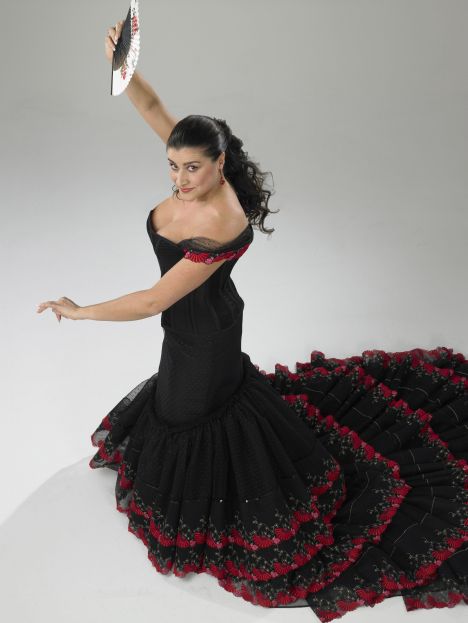
Cecilia Bartoli: Sacrificium, 2009. Photo © Universal Music.
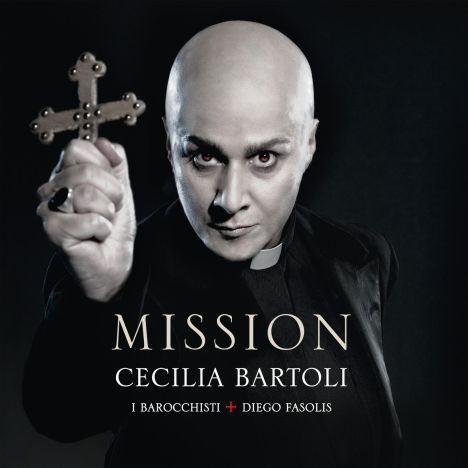
Added on March 29, 2013: Cecilia Bartoli’s album Mission (2012) explores the music of the Italian composer Agostino Steffani (1654-1728). The CD includes duets with the fabulous French countertenor Amazon.com, solo arias and music recorded with the Swiss choir Coro della Radiotelevisione Svizzera. The baroque orchestra accompanying the singers are I Barocchisti from Lugano, Switzerland, conducted by Diego Fasolis. Order the CD Mission from Amazon.com, Amazon.co.uk, Amazon.de, Amazon.fr. The composer and court musician Agostini Steffani spent time in Paris, where he was influenced by Jean-Baptiste Lully (1632-87). Later in Germany, he learned about the principles of counterpoint. The musical career of Agostini Steffani ended when he became a diplomat and high level representative of the church, for instance in Hannover and Munich. He arranged weddings, helped broker peace agreements and worked as a spy.

Cecilia Bartoli in 2012. Photos Coypright © Decca / Uli Weber. Order the CD Mission from Amazon.com, Amazon.co.uk, Amazon.de, Amazon.fr.

Added on October 1, 2010: The new double-CD by Cecilia Bartoli: Sospiri. It contains a compilation of previously recorded music as well as new material. Sospiri offers arias by Mozart and Händel as well as bel canto pieces by Bellini and Rossini. Cecilia Bartoli sings duets with Bryn Terfel and Luciano Pavarotti. She stars together with violinist Maxim Vengerov in Mendelsohn’s Ah, ritorna, from the rarely performed aria Infelice. Also included is a new interpretation of Rosina’s aria Una voce poco fa from Il Barbiere di Siviglia, the role which made Cecilia Bartoli famous. A highlight is Climaco’s aria Cervo in bosco from Il Medo, written by Leonardo Vinci for the famous castrato Farinelli. Other compositions on the double-album are by Persiani, Franck, Bach and others. The Orchestra La Scintilla was conducted by Marc Minkowski. Order Sospiri, the double-CD Prestige edition, officially released today, from Amazon.com, Amazon.co.uk, Amazon.fr, Amazon.de.
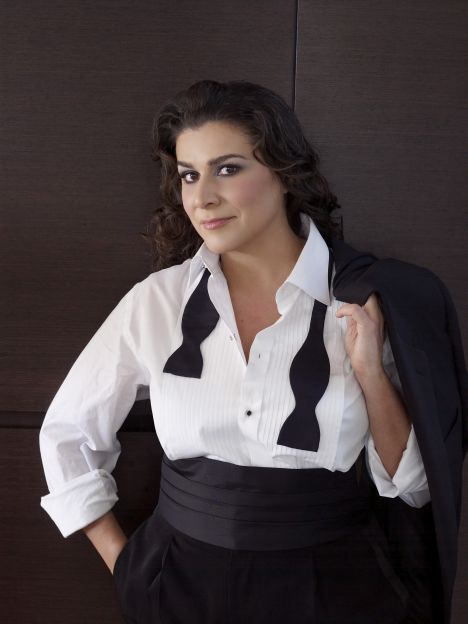
Cecilia Bartoli. Sacrificium 2009. Photos © Universal Music. Cecilia Bartoli with the orchestra Il Giardino Armonico Giovanni Antonini: Sacrificium.Decca, 2009. Order this double CD with booklet (150 pages in English, French and German) from Amazon.com, Amazon.co.uk, Amazon.fr, Amazon.de.